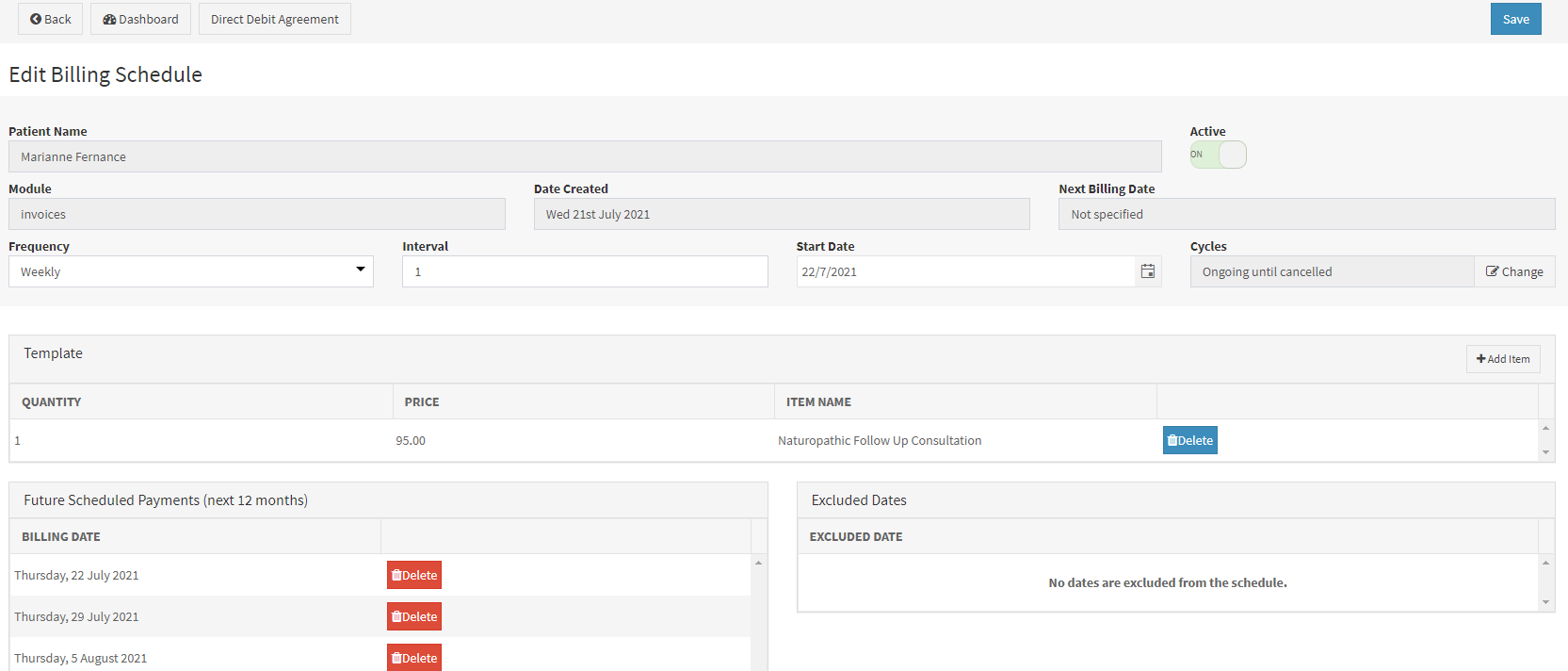THIS HAS BEEN UNPUBLISHED AS IT IS A DUPLICATE - DO NOT USE THIS
This article discusses how to setup billing schedules.
You will first need to ensure you have Square, Stripe OR Ezi-Debit connected from Business Setup - > Integrations
If you already have payment details: Select Patients -> Patient record -> Payment Details -> ADD NEW -> Payment Gateway -> Choose the preferred method -> Once selected, you can enter the card details -> SAVE.
This will now setup your patient as a payee with payment gateway. The patient's credit card details won't be seen after this, but you can update new credit card details but the old ones will never be shown in SimpleClinic.
If you need to collect payment details: When you get to Step 9, after creating the schedule following the steps below, you will have the option to open the Direct Debit Agreement. This provides a form that the user can complete in the clinic or online summarising their payment schedule and collecting payment information. The client will be able to sign it electronically. If you are sending this to the client, you will need to copy the url and email separately.
1. Next, create the invoice for your patient for the amount that will be charged on a recurring basis. (Service with supplements, service only, supplements only etc.). Please note that discounts will not be transferred to the billing schedule, please discount each item if necessary.
2. Select Create Billing Schedule in the top action bar, this will open the below screen:

3. This allows you set the:
- frequency - weekly, fortnightly, monthly
- interval - every 2 weeks, every 1 month, every 1 fortnight etc
- start date - when should the billing cycle start
- cycles - how many times will this schedule repeat? You can allow it recur with no end until it's cancelled
4. The schedule will also show future scheduled payments and allow you to remove an upcoming payments if needed.
5. Click SAVE
SimpleClinic DOES NOT store your client credit card details. These are stored securely on your payment gateway servers.
6. If you have not taken payment card details, leave it as INACTIVE. If you have already taken payment card details, set the Billing Schedule as ACTIVE.
7. Scroll to the bottom and add an email subject and email body, this will be sent to the client each time an invoice is due/paid, e.g. Your next payment is due to be taken out today. Thank you.
8. Click SAVE.
9. Optional: If you have not yet collected card details from the client:
- ensure the billing schedule is INACTIVE
- open the Direct Debit Agreement, using the button at the top of the screen (see screenshot in step 2).
- If they are with you in person, ask them to fill it out.
- If you are emailing this to the client, you will need to copy the url from the address bar in the browser and email it separately to the client.
- Once the client has signed and added payment details, these will show on the patient file in SimpleClinic, under Payment Details and the Billing Schedule will be set to ACTIVE automatically.
Please Note: If they sign and do not provide payment details, these will be not be saved. Invoices will be generated as per schedule but no payment will be processed.
10. FINAL STEP: After completing the billing schedule, you can delete (or hide) the original invoice that was used as a template to create the billing scheduled - provided there is not a payment associated with that invoice already.
Additional Information
Note: You will be notified after this process has cleared, any errors will be notified to you through the banner on Dashboard.
Schedules will be inactive when created from an invoice or an enrolment. They will be activated by one of the following conditions occurring.
1. an enrolment is activated when the enrolment has no up front payment and only an going payment
2. an enrolment with an upfront payment has the initial payment paid
3. the patient signs the direct debit agreement
4. the practitioner activates the enrolment manually if payment details are already on file.
Below is an example Direct Debit form if the client was completing this themselves:

